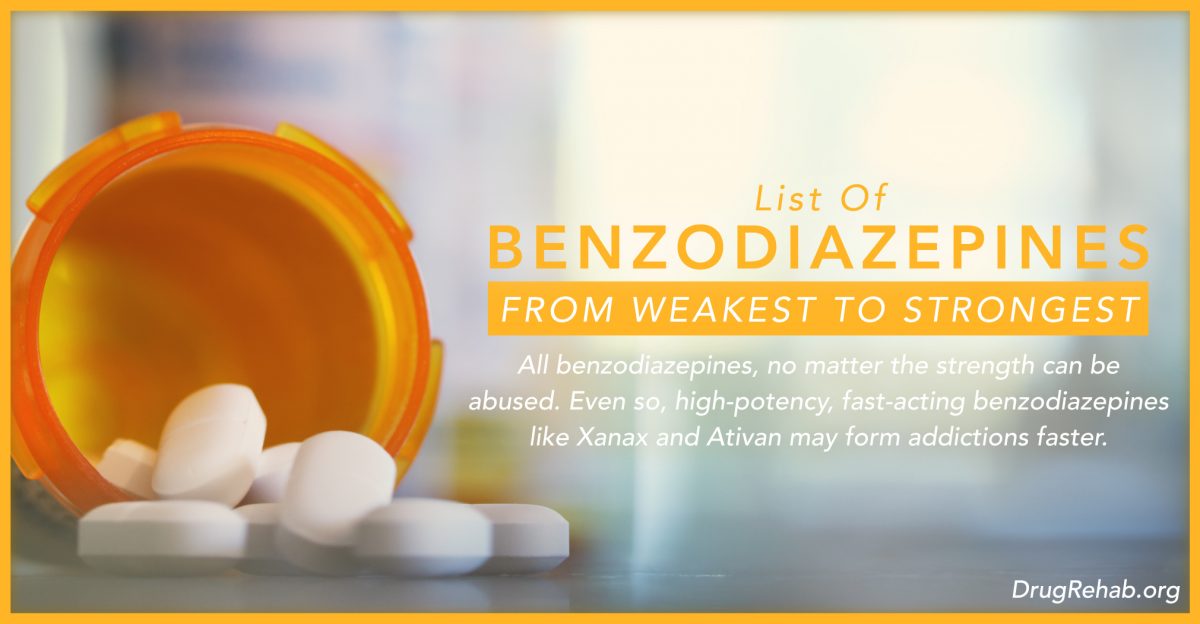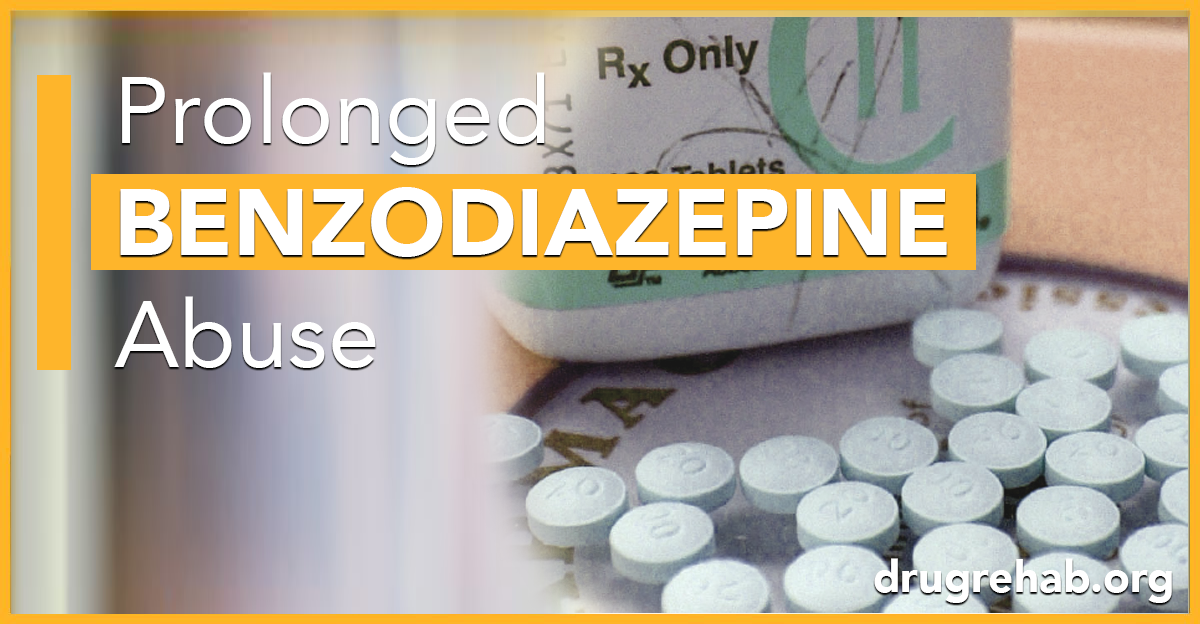
All benzodiazepine drugs have the potential for abuse, some more so than others. When determining a benzodiazepine’s strength, there are two things to consider: the drug’s potency and its half-life. A half-life measures how long a drug takes to break down and exit the body. A low potency benzo with a long half-life is weaker than a high-potency benzo with a short half-life.
Drugs with a shorter half-life, while more short-acting, are often felt more intensely. Drugs with a short half-life also create their effect more rapidly. These characteristics make these substances more attractive to recreational drug abusers. Benzodiazepine drug abusers often prefer short-acting, high-potency benzos, such as lorazepam or alprazolam, due to their fairly rapid and intense high.
Here’s a list of benzodiazepines, from weakest to strongest:
Low-potency benzodiazepines
With a long half-life:
chlordiazepoxide (Librium)
clorazepate (Tranxene)
diazepam (Valium)
flurazepam
With a short half-life:
oxazepam (Serax)
temazepam (Restoril)
High-potency benzodiazepines
With a long half-life:
clonazepam (Klonopin)
With a short half-life:
alprazolam (Xanax)
lorazepam (Ativan)
triazolam (Halcion)
Though not prescribed in the United States, flunitrazepam (Rohypnol) is sold illicitly on the streets. Used as a date rape drug, Rohypnol is a high-potency benzodiazepine with a relatively long half-life.
About Benzodiazepines
Benzodiazepine medications are sedative-hypnotics, meaning they create calming or tranquilizing effects. Because of this, these drugs are prescribed to treat anxiety, insomnia, panic and seizure disorders, and symptoms of alcohol withdrawal. Certain ones may also be used as muscle relaxants. The same actions which make these medications valuable within treatment also make them enticing to drug abusers.
Benzodiazepines take several forms, including as an extended-release (long-acting) capsule, liquid, tablet, or orally-disintegrating tablet. Any of these forms may be abused to create a sedated effect or euphoria.
When abused, benzodiazepines are taken orally in doses larger and more frequent than would be prescribed. The medication may also be crushed so that it can be snorted, smoked, or injected. No matter how benzodiazepines are abused, the potential for dependence and addiction runs high.
Are you or a loved one suffering from addiction?
Don't wait, get the best treatment options today
Call Now: (833) 473-4227Risks And Dangers Of Benzodiazepine Abuse
Aside from addiction, benzodiazepine abuse carries with it a host of adverse health effects and dangers. These include:
- Alzheimer’s disease and dementia
- birth defects
- confusion
- falls and injuries
- irregular heartbeat
- motor vehicle accidents
- robbery
- sexual assault
- vertigo
Like all forms of drug abuse, individuals who abuse benzodiazepines frequently experience an extreme loss of quality of life. In many cases, the need to use the drug becomes so extreme that it overrules a person’s desire to take care of their family or fulfill other obligations, such as those relating to work or school.
Benzodiazepine abuse has been linked to increased risks of suicide and suicidal ideation (thoughts of suicide). Chronic use of these drugs may change a person’s ability to feel emotions. Some people struggle to feel any emotions at all, a state referred to as “emotional anesthesia.”

Prolonged benzodiazepine abuse can cause some of the very problems the drugs are designed to treat. When a physically-dependent person quits benzodiazepines, withdrawal can set in. In certain cases, withdrawal may last for several months. This is called post-acute withdrawal syndrome (PAWS). Individuals facing PAWS experience anxiety, depression, and insomnia.
Acute withdrawal from benzodiazepine drugs can become very dangerous, to the extent that professional treatment is necessary (medical detox). Certain individuals may experience withdrawal so severe that their life is in jeopardy. In these instances, withdrawal may cause seizures or delirium tremens.
Overdose From Benzodiazepines
One of the greatest risks of benzodiazepine abuse is overdose. According to the CDC, from 2010 to 2014, two of the top 10 drugs responsible for overdose deaths were benzodiazepines. These were alprazolam (Xanax) and diazepam (Valium).
As central nervous system (CNS) depressants, benzodiazepines have the capacity to slow vital life support systems to deadly levels. When this happens, a person’s body temperature, blood pressure, breathing, and heart rates can no longer sustain life.
Benzodiazepines are frequently abused with other drugs, commonly with alcohol and opioids, both of which are also central nervous system depressants. This combination makes benzodiazepines even more dangerous and deadly.
Signs of overdose from benzodiazepines include blue fingernails, double vision, impaired coordination, slurred speech, and slowed or stopped breathing, among others.
An overdose is a medical emergency. If an overdose is suspected, contact emergency medical support services immediately.
Find Treatment For A Benzodiazepine Addiction
Benzodiazepine addiction is serious, and treatment often requires a medically-supervised detoxification program prior to drug rehabilitation.
The behavioral and mental impacts of addiction run deep, and this combination of factors often requires more intensive care. Inpatient drug rehab programs are designed to meet these needs, by a combination of psychotherapies and evidenced-based treatment methods.
For More Information, Be Sure To Check Out These Additional Resources From DrugRehab.org:
- The Dangers of Mixing Alcohol with Valium (Diazepam)
- The Effect Of Benzodiazepines On The Brain
- Commonly Abused Benzodiazepines
- How To Detox From Benzodiazepines
Sources
American Family Physician — Addiction: Part I. Benzodiazepines—Side Effects, Abuse Risk and Alternatives
Centers for Disease Control and Prevention — National Vital Statistics Reports: Drugs Most Frequently Involved in Drug Overdose Deaths: United States, 2010–2014
Medscape — Benzodiazepine Equivalency Table

